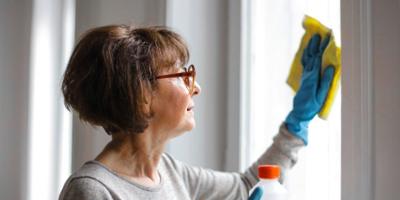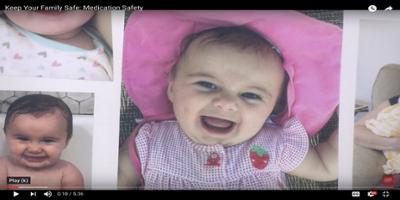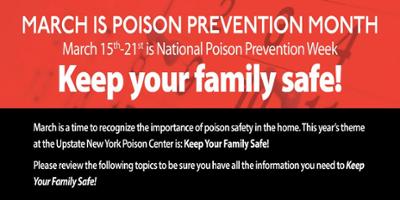In a move to keep children safe from poisonings, Upstate will send some patients home with medicine lock boxes
FOR RELEASE: Feb. 26, 2020
SYRACUSE, N.Y. - The Upstate New York Poison Center in partnership with Upstate University Hospital Department of Pharmacy with funding provided by the Advocates for Upstate and the Upstate Foundation have created a program to provide free medication lock boxes to some adult patients and children being discharged from Upstate University Hospital as a means to protect children from unintentional drug poisonings.
Those who will receive lock boxes include any patients who were treated for an unintentional or intentional drug overdose or poisoning at Upstate’s Pediatric Emergency Room; adult patients who are being discharged with a prescription for a narcotic drug and who have children under the age of 18 years old living at home; and any patient at Upstate’s Emergency Opioid Bridge Clinic who has children under 18 years old living at home.
The program initially started in the fall with 100 boxes distributed at Upstate University Hospital, funded through a grant from the Advocates for Upstate Medical University. The program has been expanded, thanks to a new grant from the Upstate Foundation, to include nearly 1,000 medication lock boxes. This expansion will allow Upstate to further reach its target population.
“This initiative will hopefully decrease the potential for unintentional drug exposures in children and our goal is to provide this service on a much larger scale in the future,” said Jeanna M. Marraffa, Pharm.D., DABAT, Clinical Toxicologist from the Upstate New York Poison Center.
Pediatric exposure to pharmaceutical products is a preventable cause of injury.
The National Poison Data System’s annual report in 2017, the year for which statistics are available, says there were 956,871 calls to Poison Centers regarding exposures in children under 6 years old. Nationally, there were 12 pediatric deaths reported in 2017 in children under the age of 6.
In 2019, the Upstate New York Poison Center managed 18,798 calls regarding children less the 6 years old. Nearly 9,000 of these calls were due to unintentional exposures to medicines.
Pain medicine, antihistamines, cardiovascular drugs and antidepressants are the top pharmaceuticals involved in pediatric poisoning and result in 171,327 exposure calls to poison centers. Additionally, teens are at increased risk of misuse of opioids and often they gain access to these medications in their own homes from old prescriptions.
“This is an important initiative that can keep children safe, where they spend the most time—at home,” said Gregory Conners, MD, MPH, MBA, chair of the Department of Pediatrics and executive director of the Upstate Golisano Children’s Hospital. “I’m grateful to the Upstate New York Poison Center, the Advocates for Upstate Medical University, the Upstate Foundation, the Department of Pharmacy and other groups and health care professionals within our academic medical center who make it a priority to keep our children safe and healthy.”
“Preventing access to medications in the home helps lower the risk of an unintentional poisoning, especially in a child,” said Upstate University Hospital CEO Robert Corona, DO, MBA. “With support from numerous Upstate entities, we are able to provide patients with a medicine lock box for the safe storage of medications when they leave our hospital.”
The medication lock boxes will be offered to families upon discharge from the hospital or emergency department.

The boxes can hold numerous prescription bottles and are secured with a combination lock. They measure 10 inches in length by 7 and a half inches wide and 5 inches in height. Each box comes complete with instructions for use, information on how to safely and properly dispose of unwanted medication, as well as information on the Upstate New York Poison Center and the number to contact in case of poisoning (1-800-222-1222).
The medication lock boxes are also being offered to patients in Upstate’s Meds to Beds program, which features the delivery to patients of prescription medications before they are discharged.
The small pilot program began last year with funding provided by the Advocates for Upstate Medical University. “This is an important initiative aimed at keeping children safe,” said Tracy Ryder, co-president of the Advocates for Upstate Medical University. “We are grateful to have provided the initial funding to support and start this program at Upstate.”
The Upstate Foundation continued the program with additional funding. “The Foundation is pleased to support the efforts of so many at Upstate who work to ensure the health and safety of our patients and families,” said Toni Gary, assistant vice president for community relations and development at Upstate Golisano Children’s Hospital.
In the case of a poisoning or for information purposes, call the Upstate New York Poison Center at 1-800-222-1222. We are open 24/7, 365 days a year. Each year our center manages more than 50,000 calls from health care providers, 911 operators, hospitals, industry, schools, and the general public in our 54-county service area.
Follow us on Facebook and Twitter to stay up to date with the latest information.
About Upstate New York Poison Center
Housed inside Upstate Medical University in Syracuse, NY, the Upstate New York Poison Center is dedicated to reducing the number, cost and severity of poisonings within its designated 54-county service area as mandated by New York State Law. The Center is available 24 hours a day, 365 days a year to both health professionals and the general public at 1-800-222-1222.
About Upstate Medical University
SUNY Upstate Medical University in Syracuse, NY, is the only academic medical center in Central New York. It is also the region's largest employer with 9,460 employees. Affiliated with the State University of New York, Upstate's mission is to improve the health of the community through education, biomedical research and health care.





